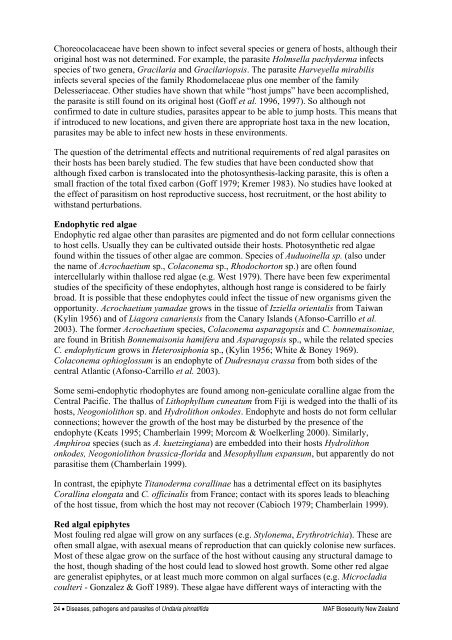Diseases, pathogens and parasites of Undaria pinnatifida
Diseases, pathogens and parasites of Undaria pinnatifida
Diseases, pathogens and parasites of Undaria pinnatifida
Create successful ePaper yourself
Turn your PDF publications into a flip-book with our unique Google optimized e-Paper software.
Choreocolacaceae have been shown to infect several species or genera <strong>of</strong> hosts, although their<br />
original host was not determined. For example, the parasite Holmsella pachyderma infects<br />
species <strong>of</strong> two genera, Gracilaria <strong>and</strong> Gracilariopsis. The parasite Harveyella mirabilis<br />
infects several species <strong>of</strong> the family Rhodomelaceae plus one member <strong>of</strong> the family<br />
Delesseriaceae. Other studies have shown that while “host jumps” have been accomplished,<br />
the parasite is still found on its original host (G<strong>of</strong>f et al. 1996, 1997). So although not<br />
confirmed to date in culture studies, <strong>parasites</strong> appear to be able to jump hosts. This means that<br />
if introduced to new locations, <strong>and</strong> given there are appropriate host taxa in the new location,<br />
<strong>parasites</strong> may be able to infect new hosts in these environments.<br />
The question <strong>of</strong> the detrimental effects <strong>and</strong> nutritional requirements <strong>of</strong> red algal <strong>parasites</strong> on<br />
their hosts has been barely studied. The few studies that have been conducted show that<br />
although fixed carbon is translocated into the photosynthesis-lacking parasite, this is <strong>of</strong>ten a<br />
small fraction <strong>of</strong> the total fixed carbon (G<strong>of</strong>f 1979; Kremer 1983). No studies have looked at<br />
the effect <strong>of</strong> parasitism on host reproductive success, host recruitment, or the host ability to<br />
withst<strong>and</strong> perturbations.<br />
Endophytic red algae<br />
Endophytic red algae other than <strong>parasites</strong> are pigmented <strong>and</strong> do not form cellular connections<br />
to host cells. Usually they can be cultivated outside their hosts. Photosynthetic red algae<br />
found within the tissues <strong>of</strong> other algae are common. Species <strong>of</strong> Auduoinella sp. (also under<br />
the name <strong>of</strong> Acrochaetium sp., Colaconema sp., Rhodochorton sp.) are <strong>of</strong>ten found<br />
intercellularly within thallose red algae (e.g. West 1979). There have been few experimental<br />
studies <strong>of</strong> the specificity <strong>of</strong> these endophytes, although host range is considered to be fairly<br />
broad. It is possible that these endophytes could infect the tissue <strong>of</strong> new organisms given the<br />
opportunity. Acrochaetium yamadae grows in the tissue <strong>of</strong> Izziella orientalis from Taiwan<br />
(Kylin 1956) <strong>and</strong> <strong>of</strong> Liagora canariensis from the Canary Isl<strong>and</strong>s (Afonso-Carrillo et al.<br />
2003). The former Acrochaetium species, Colaconema asparagopsis <strong>and</strong> C. bonnemaisoniae,<br />
are found in British Bonnemaisonia hamifera <strong>and</strong> Asparagopsis sp., while the related species<br />
C. endophyticum grows in Heterosiphonia sp., (Kylin 1956; White & Boney 1969).<br />
Colaconema ophioglossum is an endophyte <strong>of</strong> Dudresnaya crassa from both sides <strong>of</strong> the<br />
central Atlantic (Afonso-Carrillo et al. 2003).<br />
Some semi-endophytic rhodophytes are found among non-geniculate coralline algae from the<br />
Central Pacific. The thallus <strong>of</strong> Lithophyllum cuneatum from Fiji is wedged into the thalli <strong>of</strong> its<br />
hosts, Neogoniolithon sp. <strong>and</strong> Hydrolithon onkodes. Endophyte <strong>and</strong> hosts do not form cellular<br />
connections; however the growth <strong>of</strong> the host may be disturbed by the presence <strong>of</strong> the<br />
endophyte (Keats 1995; Chamberlain 1999; Morcom & Woelkerling 2000). Similarly,<br />
Amphiroa species (such as A. kuetzingiana) are embedded into their hosts Hydrolithon<br />
onkodes, Neogoniolithon brassica-florida <strong>and</strong> Mesophyllum expansum, but apparently do not<br />
parasitise them (Chamberlain 1999).<br />
In contrast, the epiphyte Titanoderma corallinae has a detrimental effect on its basiphytes<br />
Corallina elongata <strong>and</strong> C. <strong>of</strong>ficinalis from France; contact with its spores leads to bleaching<br />
<strong>of</strong> the host tissue, from which the host may not recover (Cabioch 1979; Chamberlain 1999).<br />
Red algal epiphytes<br />
Most fouling red algae will grow on any surfaces (e.g. Stylonema, Erythrotrichia). These are<br />
<strong>of</strong>ten small algae, with asexual means <strong>of</strong> reproduction that can quickly colonise new surfaces.<br />
Most <strong>of</strong> these algae grow on the surface <strong>of</strong> the host without causing any structural damage to<br />
the host, though shading <strong>of</strong> the host could lead to slowed host growth. Some other red algae<br />
are generalist epiphytes, or at least much more common on algal surfaces (e.g. Microcladia<br />
coulteri - Gonzalez & G<strong>of</strong>f 1989). These algae have different ways <strong>of</strong> interacting with the<br />
24 • <strong>Diseases</strong>, <strong>pathogens</strong> <strong>and</strong> <strong>parasites</strong> <strong>of</strong> <strong>Undaria</strong> <strong>pinnatifida</strong> MAF Biosecurity New Zeal<strong>and</strong>

















